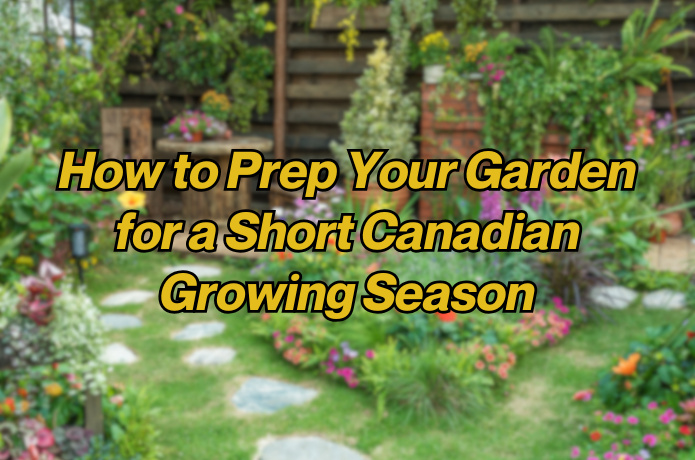How to Prep Your Garden for a Short Canadian Growing Season
How to Prep Your Garden for a Short Canadian Growing Season

Gardening in Canada comes with its own set of challenges. One of the biggest is the short growing season. In many parts of the country, frost can stick around well into spring and return early in the fall. This means gardeners have a limited window to plant, grow, and harvest. To make the most of this limited time, it’s important to plan carefully and start your garden prep early. With the right steps, even a short season can bring strong results and a healthy garden.
Whether you're growing vegetables, herbs, or flowers, preparation is key. It’s not just about when you plant, but also how you prepare the soil, choose the right plants, and protect them from unexpected weather. A few smart choices early in the season can make your gardening experience easier and more successful. If you live in a colder region, like parts of Alberta or Northern Ontario, learning how to prep your garden for a short Canadian growing season can help you enjoy a more productive garden year after year.
Know Your Hardiness Zone
One of the first things to do when planning a garden in Canada is to check your plant hardiness zone. This zone tells you which plants grow best in your area based on temperature and climate. Canada has zones that range from 0 to 9, with lower numbers being colder areas. Knowing your zone helps you pick plants that will survive the local weather and grow well in the short season.
For example, if you're in Zone 3 or 4, you'll want to choose plants that mature quickly and can handle some cooler temperatures. Seed packets and garden centres often list which zones the plants grow best in. Sticking to your zone helps you avoid planting things that won’t survive or won’t have time to fully grow.
Start Seeds Indoors
Starting seeds indoors is one of the best ways to beat the short growing season. You can get a head start by planting seeds inside your home 6 to 8 weeks before the last frost date in your area. This means your plants are already growing when it’s finally warm enough to move them outdoors.
Use small pots or seed trays and keep them near a sunny window or under grow lights. Vegetables like tomatoes, peppers, and herbs benefit from being started indoors. Once the weather warms up, you can transplant them into your garden, giving them a strong head start compared to seeds planted directly in the soil.
Use Raised Garden Beds
Raised garden beds warm up faster in the spring and drain water more easily. This is especially helpful in Canadian regions where the ground can stay cold and wet well into May. Raised beds also give you more control over soil quality and allow you to start planting earlier.
You can build your own raised garden bed with wood or buy pre-made kits. Fill them with a mix of quality garden soil and compost to give your plants a healthy start. Because the soil warms up faster, seeds will sprout more quickly, helping you get ahead of the short season.
Prepare Your Soil Early
Healthy soil is key to a successful garden. As soon as the ground is thawed and dry enough to work with, start preparing your soil. Remove any weeds, dead leaves, or leftover plants from last year. Then loosen the soil with a garden fork or shovel to help with air and water flow.
Adding organic matter like compost or aged manure will improve the soil and give plants the nutrients they need. If you're not sure about your soil's quality, you can buy a simple soil test kit. This will tell you if your soil needs more nutrients or a change in pH to support healthy plant growth.
Choose Fast-Growing and Cold-Hardy Plants
In a short growing season, you want plants that grow fast and don’t need a long time to mature. Look for vegetables with shorter days to harvest. Some great options include radishes, lettuce, peas, beans, spinach, and kale. These plants often grow well in cooler temperatures too.
Herbs like parsley, cilantro, and chives also grow quickly and are perfect for small gardens. If you want to grow flowers, try marigolds, pansies, or snapdragons. These are not only colourful but can also handle cooler spring temperatures, giving your garden a boost early in the season.
Use Row Covers and Cold Frames
Spring weather in Canada can be unpredictable. Even after the last frost date, cold nights can still happen. To protect your plants from unexpected drops in temperature, use row covers or cold frames. These simple tools help keep your plants warm and shielded from wind and frost.
Row covers are light fabric sheets that go over your garden beds. They trap heat during the day and provide insulation at night. Cold frames are small, box-like structures with clear lids that act like mini greenhouses. They’re especially useful for hardening off plants or starting seeds early outdoors.
Water Smartly and Mulch Well
Once your garden is planted, it’s important to water it regularly, especially during hot spells. Early in the season, plants don’t need as much water, but as the days warm up, their thirst increases. Water in the early morning or late evening to help the soil hold moisture longer and avoid evaporation.
Adding mulch around your plants is another great step. Mulch helps lock in moisture, keeps weeds down, and can even keep the soil warmer. Use natural mulch like straw, shredded leaves, or wood chips. This is especially helpful during cold nights or when the weather changes quickly.
Keep an Eye on the Weather
Because the growing season is short, staying updated on your local weather is important. Watch for frost warnings, heatwaves, or heavy rain. Being prepared can help you protect your garden in time. If frost is in the forecast, cover your plants with blankets or move potted plants indoors.
Using a Canadian frost date chart can also help you better plan your planting schedule. It tells you the average last frost date in spring and the first frost in fall. Counting the days between those dates gives you a better idea of how long your growing season really is.
Plan for Succession Planting
Succession planting means planting new crops after the first ones are harvested. This helps you grow more food in less time. For example, once your radishes or lettuce are picked, plant a new batch in the same spot. This works well for fast-growing vegetables and gives you fresh produce throughout the summer.
Keep a list of which plants mature quickly and plan your garden so there’s always something new growing. This method helps you use every bit of space and time during the short Canadian gardening season.
Prepping your garden for a short Canadian growing season takes some planning, but the rewards are worth it. By understanding your hardiness zone, starting seeds indoors, and choosing the right plants, you can make the most of the limited time. Raised beds, quality soil, and protective tools like row covers all help you get a jump on the season.
Whether you're growing food for your family or adding colour with flowers, a well-prepared garden can bring great results even in a short time. With smart choices and early action, your garden can thrive from spring to fall—no matter where in Canada you live.

